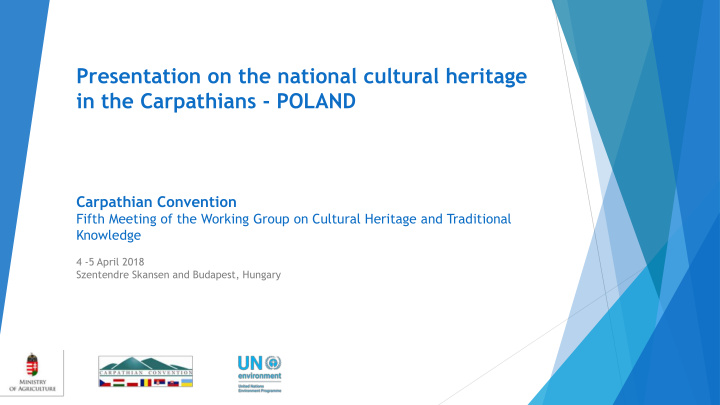



Presentation on the national cultural heritage in the Carpathians - POLAND Carpathian Convention Fifth Meeting of the Working Group on Cultural Heritage and Traditional Knowledge 4 -5 April 2018 Szentendre Skansen and Budapest, Hungary
Wooden Tserkvas of the Carpathian Region in Poland and Ukraine UNESCO World Heritage List (2013). Situated in the eastern fringe of Central Europe, the transnational property numbers a selection of sixteen tserkvas (churches). They were built of horizontal wooden logs between the 16 th and 19 th centuries by communities of Orthodox and Greek Catholic faiths. Important elements of some tserkvas include wooden bell towers, churchyards, gatehouses and graveyards. Author: National Heritage Board of Poland CC WG Cultural Heritage, 4 -5 April 2018, Hungary
Wooden Churches of Southern Małopolska UNESCO World Heritage List (2003). The wooden churches of southern Little Poland represent outstanding examples of the different aspects of medieval church-building traditions in Roman Catholic culture. Built using the horizontal log technique, common in eastern and northern Europe since the Middle Ages, these churches were sponsored by noble families and became status symbols. They offered an alternative to the stone structures erected in urban centres. Author: Narodowy Instytut Dziedzictwa CC WG Cultural Heritage, 4 -5 April 2018, Hungary
Wieliczka and Bochnia Royal Salt Mines The deposit of rock salt in Wieliczka and Bochnia has been mined since the 13th century. This major industrial undertaking has royal status and is the oldest of its type in Europe. The site is a serial property consisting of Wieliczka and Bochnia salt mines and Wieliczka Saltworks Castle. The Wieliczka and Bochnia Royal Salt Mines illustrate the historic stages of the development of mining techniques in Europe from the 13th to the 20th centuries: both mines have hundreds of kilometers of galleries with works of art, underground chapels and statues sculpted in the salt, making a fascinating pilgrimage into the past. Author: National Heritage Board of Poland CC WG Cultural Heritage, 4 -5 April 2018, Hungary
Knowledge of producing an instrument and practice of playing koza (goat - Podhale bagpipes) The instrument called koza is one of the oldest elements of the highlander culture, coming directly from the Wallachian culture. It has functioned in the cultural space of Podhale from the 16th century. Music played on a goat has always played a significant role in Podhalan's life. Shepards took the instrument to the halls. The music of the goat resounded during weddings and other social events. Since 1998, on the initiative of Jan Karpiel Bułeck a, "Dudaskie Ostatki" has been organized in Zakopane - an annual meeting and concert of pipers from all over Poland and invited countries. NID CC WG Cultural Heritage, 4 -5 April 2018, Hungary
Gajdy - the knowledge of producing the instrument and the practice of playing Gajdy - it is a musical instrument characteristic of the Silesian Beskids. The practice of playing and the knowledge how to make gajdy is an integral part of the music tradition of the Beskid region, it gives a regional identity. NID CC WG Cultural Heritage, 4 -5 April 2018, Hungary
Bagpipe culture Slovakia Inscribed in 2015 (10.COM) on the Representative List of the Intangible Cultural Heritage of Humanity Slovak Intangible Cultural Heritage Center CC WG Cultural Heritage, 4 -5 April 2018, Hungary
Joanna Cicha- Kuczyńska Ministry of Culture and National Heritage jcicha@mkidn.gov.pl CC WG Cultural Heritage, 4 -5 April 2018, Hungary
Recommend
More recommend